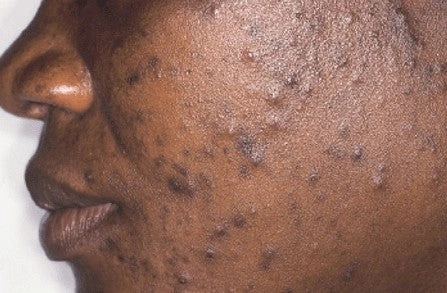Author's details
- Hakim A Abubakre
- BA (Hons) International Business Management, Msc Digital Marketing.
Reviewer's details
- Dr. Khashau Eleburuike
- MBBS (Ilorin) MSc. Global Health Karolinska Institute.
- Resident doctor in family medicine in Northen Sweden.

- Date Published: 2025-06-11
- Date Updated: 2025-06-11
Understanding and Managing Acne
Patient Information Leaflet: Understanding and Managing Acne
Adapted for Sub-Saharan African Settings
What is Acne?
Acne is a common skin condition where small bumps, pimples, or spots appear on the skin due to clogged or inflamed oil glands (sebaceous glands). These glands produce a natural oil called sebum, which helps to keep the skin and hair hydrated and healthy. When too much oil, dead skin, or bacteria build up in hair follicles, acne can develop.
Acne is not contagious, and it is not caused by poor hygiene, curses, or spiritual forces — although these are common misconceptions in many communities.
Types of Acne (What It Looks Like)
Acne can appear in different forms:
- Blackheads: Open pores with a black center caused by trapped oil and dead skin.
- Whiteheads: Closed bumps that stay under the skin, appearing white or yellowish.
- Papules: Small, red, tender bumps.
- Pustules: Pimples with pus at their tips, often surrounded by red skin.
- Nodules: Large, painful lumps beneath the skin.
- Cysts: Deep, painful bumps filled with thick fluid. These can cause scarring.
These lesions are most found on the face, back, chest, shoulders, and upper arms. In rare cases, acne can also appear on the scalp, armpits, buttocks, ears, eyelids, and external genitals.
Who Gets Acne?
- Most common among teenagers and young adults due to hormonal changes.
- Can also affect:
- Babies (known as neonatal acne)
- Adults in their 20s, 30s, and even later
- People with oily or combination skin types, which are common in hot, humid Sub-Saharan climates, may be more prone to acne.
- Family history also plays a role.
What Causes Acne?
- Hormonal changes, especially during puberty, menstruation, or pregnancy
- Excess oil production
- Clogged pores from dead skin or makeup
- Bacteria on the skin
- Certain cosmetics or hair products, especially oil-based ones
- Stress
- Unbalanced diets high in processed foods or dairy
Warning Signs and Symptoms
- Painful or warm red bumps (papules)
- Black spots in open pores (blackheads)
- White or yellow bumps (whiteheads and pustules)
- Large painful lumps under the skin (nodules or cysts)
- Discoloration or dark marks (common in darker skin tones)
Psychosocial Impact
While acne doesn’t usually affect physical health, it can affect:
- Mental health (depression, anxiety, low self-esteem)
- Social confidence
- Quality of life, especially for young people in school or social settings
Myths and Facts in Our Communities
| Myth | Fact |
|---|---|
| Acne is caused by dirt or not bathing | Acne is due to clogged pores, not lack of cleanliness |
| It is a spiritual issue or curse | Acne is a medical condition, not spiritual |
| Toothpaste or bleach clears pimples | These can damage the skin |
| Acne only affects teenagers | Adults and even babies can get acne |
Self-Care Tips (At Home Management)
- Wash your face no more than twice a day with mild soap or cleanser and lukewarm water.
- Avoid scrubbing your face too hard.
- Do not pop or squeeze pimples – it can cause infection and scarring.
- Use non-comedogenic (non-pore-clogging) and water-based skin and hair products.
- Remove all makeup before bed.
- Wash your hair regularly and keep it away from your face.
- If you sweat, shower as soon as possible.
- Try natural products cautiously – e.g., aloe vera or diluted tea tree oil may help.
- Exercise regularly to improve mood and overall health but clean your skin afterward.
When to See a Health Worker
- Acne is painful, spreading, or leaving scars
- Over-the-counter treatments stop working
- It is affecting your mental health or confidence
- You notice nodules or cysts, which can lead to long-term scarring
Health workers may recommend:
- Prescription creams or gels (e.g., benzoyl peroxide, retinoids)
- Antibiotics for moderate to severe acne
- Oral medications for hormonal acne
How to Prevent Acne
- Wash your face regularly but gently
- Use skin products that match your skin type
- Stay hydrated
- Limit makeup use; choose oil-free products
- Avoid touching your face unnecessarily
- Protect your skin from excessive sun exposure
- Manage stress through yoga, journaling, prayer, meditation, or community support
- Eat a balanced diet, limiting processed food, refined sugar, dairy, and alcohol
- Consider natural options like French green clay masks, if available locally
Dark Spots and Scars in Darker Skin
In Sub-Saharan African skin, acne can leave dark patches (post-inflammatory hyperpigmentation) even after pimples heal. Prevent this by:
- Not picking or pressing pimples
- Using sun protection (hats, umbrella, sunscreen, or staying in the shade)
- Seeking treatment early
Areas for Improvement in Local Health Systems
- Increase public awareness through school and community education
- Train more health workers on safe acne treatment for African skin types
- Improve access to affordable and culturally appropriate skin products
Combat stigmas around acne through radio, religious groups, and youth forums
Acne is common, manageable, and nothing to be ashamed of. With good habits, early care, and proper treatment, your skin can improve. If acne is causing emotional or physical distress, please seek help from a trained health worker.
- World Health Organization (WHO). Skin Diseases in Africa: An Overview.
- Mayo Clinic. Acne – Symptoms and Causes.
- American Academy of Dermatology Association. Acne Resource Center.
- NHS UK. Acne – Self-care and Treatment.
- Global Health Dermatology. Managing Acne in Darker Skin Tones.
